Public Pier — No Fishing License Required
When I first sat down to write about this pier, I almost didn’t know where to start. Should I talk about the pier itself, the municipal wharf built in 1913, the wharf which is the longest of the five wharves built here since 1853, and the longest wooden wharf on the coast of the United States, measuring 2,745 feet in length?

Should I talk about the beach and the beach area that used to be known as the Coney Island of the west—with its boardwalk, casino, and famous Giant Dipper, one of the last wooden roller coasters on the West Coast?

Should I talk about the crowds on the pier, an estimated 3-4 million people a year (which, if my mathematical calculations are correct translates into about 10,000 people a day)?
Or, should I just concentrate on the fishing which, because of the size of the pier, can be great at one spot on the pier and, at the same time, terrible just a short distance away?

Environment and Fish. More than a half-mile in length, the pier offers several different types of marine environments including the shallow water, sandy bottom found inshore, to the fairly deep water, sand and mud bottom out at the end. The one constant, and it seems a healthy one, is the pilings. Most show a good growth of fish-attracting organisms on them. Included are several types of mussels (blue mussels, black mussels, horse mussels, horse mussels, razor mussels) and barnacles (gooseneck barnacles, leaf barnacles, acorn barnacles, volcano barnacles, stripped barnacles, thatched barnacles). Joining the mussels and barnacles are sea anemones, sponges (red and yellow), tunicates, crabs, and shrimp. Added in the mix are a plethora of different sea stars in all shapes and color.
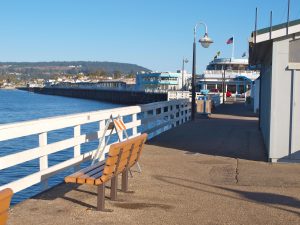
The different environments produce different fish. Inshore, just out from the sandy “Main Beach,” an angler can fish most of the year for barred and calico surfperch, and most days will yield at least a few fish. Once in a while, an angler will also hook onto a skate, flounder, or small shark, usually a leopard shark. In addition, a few old-timers (who usually know the most about the piers) will bring a few fresh mussels or worms and fish around the pilings themselves, just outside the breaker area. Their goals are primarily rubberlip, rainbow, and white seaperch as well as blackperch.
Midway out, the pier widens to accommodate restaurants, fish markets, tourist shops and bait and tackle shop; all work hard to keep the wharf’s visitors happy. The east side of the pier is reserved for fishing, launching skiff rentals, and boarding the Stagnaro Sportfishing boats which operate out of the pier.

This area is heavily fished, has a sandy bottom, and yields mostly kingfish (white croaker), walleye surfperch, silver surfperch, white seaperch, sanddabs, small sole and far too many shinerperch, although the small fish also attract the halibut to this shallower area.

The area at the end is different once again even though the bottom is still sand and mud. Various types of debris have built up under and around the pier over the years resulting in what in essence is an artificial reef. Here catches of rocky-shore species are common.

The end area
In addition, several holes are located in the middle of the pier; these are fishing wells that allow an angler to fish straight down among the pilings (an excellent idea which more piers should copy). Of course the noise around these wells can be deafening, a cacophonous mix instigated by barking sea dogs down below and raucous sea gulls up above. A few sea lions always seem to be sleeping on the crossbeams between the pilings or swimming in and out of the area; sea gulls will be sitting wherever they feel it’s safe (especially if they see food, and it doesn’t matter if it’s sea food). It’s undoubtedly one of the favorite spots for tourists to experience the call of the sea but the hubbub can grow a little tiresome for those anglers fishing the wells for just one more fish.

Fishing wells
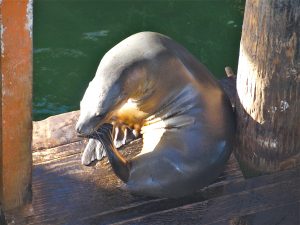
Sea lions loiter on the crossbeams of the pilings

Eat, sleep and bark

Surprisingly, the fishing in these wells can still be excellent. In fact, most of the rockfish I have caught on this pier have been caught while fishing in these wells. It also seems to be the best spot to catch large, legal size lingcod (normally during the fall or winter months). Around the outer end, an angler can still catch a few rocky-shore species, but sandy-bottom species will predominate. When pelagic species are around, like mackerel and salmon, the end is generally the best area to fish.
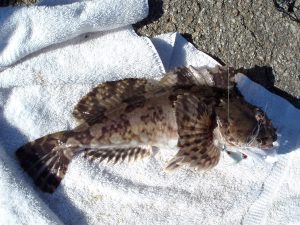
Cabezon
One problem here can be infestations of smaller fish, as well as non-fish. Several times over the years I have had to switch to larger hooks and stop using pile worms as bait. Why? Because the shinerperch were so thick that it was nigh impossible to keep them from stripping the bait intended for more desirable species. This was true in both winter and summer visits although generally only in the mid-pier areas.
A different problem arose during visits to the pier in August of 1988. When fishing from the far right end of the pier, the bottom seemed to be covered with small speckled sanddab and small red octopus. I was fishing on the bottom using a high/low leader setup. Every cast yielded two sanddab, two octopus, or one of each. Other parts of the pier saw few of either species but at that particular spot it was almost impossible to keep the small critters off the hooks. I finally switched to bigger hooks, which solved the sanddab problem but didn’t affect the octopus; they simply latched on to whatever came their way. Fortunately, I did get some revenge, as octopus is tasty when sliced up and deep-fried with a little batter. In addition, I kept a few as shark bait that proved effective when fishing in San Francisco Bay. Almost identical sanddab/octopus combinations showed up in visits during November of 2003 and July of 2007 and I imagine it’s a common occurrence.

A small speckled sanddsab
Another problem can be the Pelecanus occidentalis, the brown pelicans that so delight the tourists. Like their relatives down in Santa Barbara (as well as other piers up and down the coast), they can be very aggressive at times, hanging just a few feet away from anglers and quickly trying to snatch fish as they are unhooked from lines. Be careful, you might lose a fish or suffer a slight wound from the nip of a pelican’s beak. At the same time, careless anglers who do not watch their lines can also injure the big birds. When that happens it creates even bigger problems. This pier, as well as Capitola and Seacliff, was closed to fishing for several days in August of 2008 due to the number of pelicans being accidentally hooked by anglers.

There are several fish cleaning sinks on the wharf
City pursuing pelican-protection plan
SANTA CRUZ—When the California brown pelicans and anglers begin competing for anchovies and sardines at the Santa Cruz Municipal Wharf next fall, the city will have a new plan to protect the birds.
On the heels of an autumn that saw unprecedented numbers of birds injured off the wharf, the Santa Cruz City Council took the first step of a pelican protection plan Tuesday night. In a 7-0 vote, council members gave preliminary approval to a law that will enable the city to close the pier to fishing as needed to protect the birds. But the plan stresses education and includes trained volunteers, who will walk the pier to inform fishermen about how fishing gear can harm the state and federally endangered birds.
What was left for later is a decision on spending $17,500 for signs that detail the dangers of birds getting snared by lines and explain how to respond should that occur and $1,000 for new trash lids and rescue equipment to be stored at the wharf. Council members said they supported posting the signs, but wanted to wait until after the mid-year review of the city’s budget before committing the funds. Parks director Jim Lang said most of the birds were entangled by accident and that educating the public about the problem was key to combating it.
Pelican conservationists were obviously pleased with the action. “This program is needed up and down the coast,” said Jack Ellwanger of the Pelican Network. “Santa Cruz stepped forward.”
Council members emphasized they were not wholly closing the pier to fishing, though that could happen temporarily during times when pelican activity is high. Still, some fishermen said they were concerned about being able to continue fishing there. “I’m looking forward to seeing how it’s handled,” said David Maruska of Santa Cruz.
Last fall, some 162 birds were rescued and sent to the International Bird Center and about 40 of those died, said center spokeswoman Karen Benzel. She said it cost the center about $200 per bird to rehabilitate them. Supporters said hundreds more tangled birds could not be rescued from the water.
Each fall sees an influx of anchovies and sardines off the wharf. That lures fishermen who like to catch the tiny fish for bait and brown pelicans that like to dine on them. The hooks alone are dangerous, but so are the fishing lines. When the birds get entangled, a frustrated angler may just cut the line. The bird flies off with it still attached and it can get tangled again somewhere else.
Last fall’s influx of small fish was exceptional, Lang said. “I’ve been here 20 years and have never seen anything like it before,” Land said.
—Brian Seals, Santa Cruz Sentinel, January 23, 2002

Interesting ships

Fishing Tips. Because of its great length, this pier offers an advantage over many piers. One or more species are almost always available; you just have to find them! A disadvantage is that fishing is rarely great unless one happens to arrive when a school is in the area. It is a huge pier and gets tremendous fishing pressure year-round.
If fishing during the spring, April through June, try inshore from the breaker area out to the lifeguard station. Many years will see perch coming into the shallow waters to spawn and sometimes tremendous catches can be made. Try pile worms or fresh mussels on a size 6 or 8 hook, and fish under the pier, next to the pilings, for barred surfperch, rubberlip, rainbow, white, black and even a few striped seaperch. In addition, a few pileperch may join in the fun. Since the barred surfperch, rubberlip seaperch, and pileperch are the largest members of the perch family, anglers can often get some real quality along with the quantity. Locals will often use small plastic grubs with a sliding rig to coax these big perch.

Rainbow seaperch
During the same late spring months, but usually just a little bit further out on the pier, large schools of walleye and silver surfperch may be available to interested anglers. Fish for these smaller perch mid-depth using a multi-hook rigging sweetened with small pieces of anchovy or shrimp. Occasionally these schools will be joined by spotfin surfperch.
Much of the year the inshore area, especially the area just past the breakers, will yield barred and calico surfperch. Most anglers use pile worms or mussels for bait and a double leader set up using size 4 or 6 hooks—although ghost shrimp can be a GREAT bait. You generally will not catch a lot of barred or calico surfperch, but the ones you will catch are often nice sized fish. Again, locals will often use artificial lures and will often catch a majority of the big fish. Favorite include root beer and motor oil colored grubs and the camo or pumpkin seed Berkley Power sand worm cut in 2-inch strips.
Finally, you may want to try at night in the nearshore or mid-pier area for sharks, skates and rays. Here the best bait will be squid, and a medium-sized piece, not the whole squid, is the ticket. Anglers can get a variety of sharks including brown smoothhounds, leopard sharks, spiny dogfish, and even a few angel sharks, but the number of sharks that are caught pales in comparison to most other similar-sized piers. In fact, I’ve never really noticed the “shark specialists” that are common to so many other piers in central California. More common than sharks are bat rays and some good-sized fish can be expected (a run of large bat rays, 60-70 pounders, was reported out at the end of the pier in the spring of 2000). The late evening hours, from 9 P.M. to midnight, seems best.
If fishing during the summer or fall, check out the mid-pier area. Fish on the bottom using a small piece of anchovy, and the result will often be kingfish (white croaker), white seaperch, Pacific sanddab, speckled sanddab, English sole, sand sole or an occasional starry flounder. In addition, some years will see sharpnose seaperch landed, generally July to August. Although this is one of the very few piers where I’ve seen innkeeper worms used as bait, they appear to be good bait here for starry flounder and sole. A small wolf eel was caught in this area in early 2002; it was gently returned to the sea.

Starry flounder
For the dyed-in-the-wool halibut fishermen, April through August (or September) will yield a few fish with best fishing generally from mid-May to mid-June, and the best bait being live bait (esp. anchovies or sardines) fished on the bottom midway out on the pier where it widens. Artificials will also attract a few of the aggressive fish. Good success has been reported by those using Hair Raisers (which are normally used for striped bass). Most years will yield at least a couple of large, impressive-sized halibut, some over 30 pounds in weight.

Two halibut taken in the summer of 2018 by Roy Q
Making bait for the halibut (catching live bait) generally means the use of a self-made snag line or one of the commercial Sabiki/Lucky Lura-type multi-hook bait rigs. Quite often you will see anglers running around the pier with light poles and live bait buckets. A few casts here, a few casts there, until they locate a school of bait fish and then enough casts until they have hooked a sufficient supply of bait to last for a few hours. Most often the bait being sought will be anchovies or sardines although small Spanish mackerel (jack mackerel) or Pacific mackerel will also work well for bait.
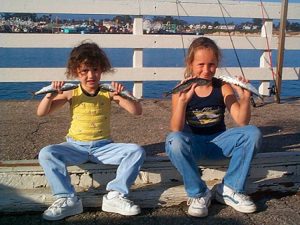
Sardines
Occasionally you might even encounter schools of Pacific herring as I did in April of ’99 (although most of the anglers erroneously mistook them for sardines). Also mixed in, especially if you let the bait rigs sink to the bottom, will be some shinerperch, spotfin surfperch or even small kingfish (white croakers), and all can be utilized for live bait.

Halibut
However, many anglers are content to keep the pelagics for themselves, they’re not worried about halibut. When the schools show up, and they can be huge, anglers will be lining the rails with multi-hook bait rigs trying to fill a bucket with the fish. All of the above bait species can be landed as well as large jacksmelt. Typically the anchovies and sardines will be found in the shallower water while the other species are in deeper water but there are no guarantees, they may be anywhere from the surf line out to the end of the wharf.
Although less common, an occasional striped bass will also be taken (and a surprised angler in 1996 pulled in a 33-pound lineside). Since the pier sits 22 feet above the water, be sure to bring a net if you seek these larger fish. Although the stripers may show up anywhere from the surf line to the end, most of the halibut are in the mid-pier area.
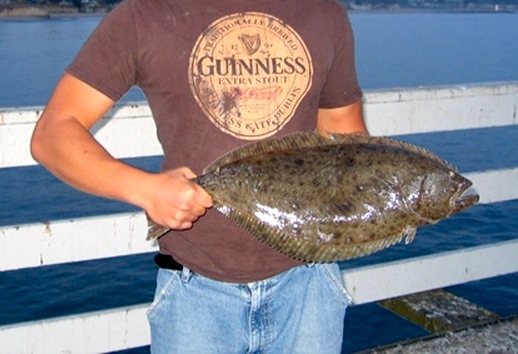
California halibut
Salmon, usually king salmon, will also generally make at least a nominal showing most years, generally out toward the end of the wharf. Most of the fish fall to regulars with the know how of using live bait fished under a float. When small mackerel are around, they are hard to beat for live bait (so bring a small bucket and aerator with you to keep them alive). In August of 2002, an unusual run took place with most of the salmon being caught inshore, between the bait shop and the surf area. Only problem was that most of the salmon were illegal, 7-10 pound silver salmon that had to be returned to the water. Luckily a few kings did show up and a number were taken on frozen anchovies fished under floats.

An unusual species of salmon, one far more common to waters to the north, was a pink salmon taken in 2018. Apparently a few migrate into local waters every other year.
Up until about the ’90s, a common summer-time visitor to the wharf was schools of immature, juvenile bocaccio. When heavy concentrations were present, anglers would flock to the pier and catch buckets of the small but tasty fish. The rigging was similar, or identical, to the bait rigs described above. The difference was in the type of jigging. Instead of the cast and retrieve method used to acquire bait, the best method was simply to drop the rigging to the bottom, next to the pier, and bring it up slowly until you found the school of fish. Once the school was located a simple up and down motion would attract and hook the fish. During the years when schools of juvenile bocaccio visited the pier, the mid-pier area generally was the hot spot for these small fish. Unfortunately, as the number of mackerel and sardines has risen, so the number of bocaccio has decreased. Only time will tell if it’s a natural up and down cycle for the fish. In the meantime, anglers are limited to two of the fish and they must be at least 10 inches in length; it’s better to just leave them alone.
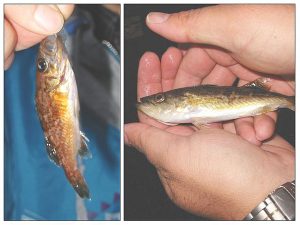
Small bocaccio
Summer to fall is also the prime time for small rockfish. For blue, brown, gopher, grass, kelp, and black and yellow rockfish, and a possible seaperch—striped, black, rubberlip or white, try fishing in the wells out toward the end of the pier. Use size 6 or 8 hooks, and pile worms, fresh mussels, ghost shrimp or small pieces of market shrimp for bait. Be cautioned that bigger fish do lurk in these holes.
In August of ‘97 I was returning from one of my trips along the coast when I decided to make a short visit to the pier. This would be the last pier I would visit on the trip, and I had used up most of my bait. So, I rigged up a high /low leader with number 6 hooks and small pieces of mackerel that I had caught in San Diego. Looking down into the last well at the end of the wharf showed a number of large sea lions taking their mid-morning siestas; I hoped they didn’t bother my line. As soon as the sinker hit the bottom I began to feel sharp taps on the bait, which is common for perch and small rockfish. The mantra: be patient and let them hook themselves, but also be prepared to strike quickly if needed. That’s what happened when there was a strong hit and the tip of the pole pulled down toward China (or possibly Tibet?). I immediately began to reel but would only gain a couple of yards of line before the fish would pull it back out. It definitely was not a small rockfish! It took a few minutes of fight, along with worry about the pilings, seaweed, and sea lions, before I got the fish to the top of the water. But it wasn’t one fish, it was a just barely legal-sized lingcod on one hook and another fish on the other hook.

Lingcod and kelp greenling
The larger fish was a brightly colored blue lingcod; the other fish was a kelp greenling. Not bad for the first drop of the day but it would also prove to be the best. Another hour’s fishing produced six more fish—gopher, brown and blue rockfish, but no more lings. My experience with lings is that if there are small rockfish or greenling in the area, there will be hungry lingcod around to eat them. Be forewarned! If you want to try specifically for the lings, use a heavier line, bigger hooks, and a strip of greenling or rockcod on your hooks. Even better is to catch one of the small rockfish and use them for live bait. You can also try artificial lures straight down in the wells—they’ll produce fish. Also, don’t be surprised if you get a mass of onlookers watching your every move. As soon as you catch one fish there will be people who want to see another, and another, and another. Do be sure to bring a net with you in case you hook that trophy fish.
Mid-to-late winter can be an interesting time, although also challenging if winter storms give siege to the area. Oftentimes these will be the months that large schools of kingfish or sanddabs saturate the area around the pier and the result can be a fish on nearly biting. They also are fine to eat; kingfish (white croaker) in this area tend to be firm-fleshed and safe to eat in contrast to their brethren found in some parts of California.
Fall and winter months will usually see a few steelhead landed, most in the 15-20 inch size category, although a few range up to about 8-pounds. Best bait seem to be a worm or cut anchovy fished under a bobber; those who prefer artificials generally use small spoons like Kastmasters.
Occasionally unusual fish will also show up at the pier, usually because of its proximity to the deep Monterey Submarine Canyon. Two unusual fish reported in June of 1997, a warm-water year, were California scorpionfish, commonly called sculpin in southern California. Pictures were not taken but since textbooks list Santa Cruz as their northern limit, it’s possible the fish were indeed scorpionfish. Most interesting was that one was reported to weigh 5-pounds which, if true, would have qualified it as a California record.
Although crabbers also flock to the pier, the results offer a mixed bag. Year round effort occurs on rock crabs while wintertime months see Dungeness-seekers added to the mix. Unfortunately most of the rock crabs caught today are on the small side while the wharf has never really been noted as a haven for Dungeness (unless you buy them from Stagnaro’s or one of the other seafood markets). Quite a few slender crabs are caught but they too tend to be small, rarely exceeding 4 inches in size. The wharf is however, a very good pier at times for spider crabs (sheep crabs) and sometimes these are huge monsters; reports in March and April of ’97 said spiders approaching 30-pounds in size had been landed.

The area by the mid-pier cleaning sink and this sign is a good area for halibut
The Pier Rats Speak
Date: August 14, 1999; To: Pier Fishing in California Message Board; From: Vee; Subject: Santa Cruz Wharf
I went out to Santa Cruz on august 13. Nice sunny day. Fishing here can be a blast for a family outing. I was there from 6 am till 1 PM and the bait was in thick. Anchovies and sardines surrounded the pier the whole day. I caught about 100-150 baitfish and bagged them up to save for future use. (By the way, what is the best way of preserving the baitfish for the next time for use?) I caught a few rock cod, sand dabs, perch, lingcod (undersized), and saw a lot of people catching smelt. One guy even caught an eel. The sea lions are everywhere and they are quite pesky. I was hoping to catch some halibut or a striper, but had no luck. I know they are there because I saw the sea lions eating and playing with remains of a big halibut. Although the bait was in, there were no signs of game fish today (better luck next time I guess].
Date: May 26, 2001; To: Pier Fishing in California Message Board; From: Ed; Subject: Santa Cruz Wharf—Sardines!
Went down this morning for a “quickie” and stocked up on real nice bait-sized sardines. Lots of them there now, thick enough to darken the water at times. I fished just before the boat rental office on the right side where the Marcella is. These fish are perfect for bait, most around 6-7” with some larger ones mixed in. I just finished sorting them and putting them in the freezer for striper and halibut trips. If you want to get some for bait bring something with a lot of ice in it to keep the fish and put them in as you catch them. It makes them much nicer when defrosted and they don’t get mushy. It’s worth the extra effort.
Gotta tell you the story of how I ended up fishing down there today…. I had pretty much resigned myself to a fishless weekend since my wife and older daughter are out of town and I’m home with our three-year-old. I thought I’d just hang low and keep her busy and happy some how. Now, she’s deaf and cannot speak but that sure didn’t stop her from letting me know what she wanted to do today. We’re sitting at the table having breakfast and she flashes me the sign for “fish.” I flash it back, shake my head “yes” and think nothing of it because she’ll flash sign for no reason once in a while. She quickly follows that up with a sign she made up that we know means “fishing.” Then she runs away from the table and comes back with a picture of some sea lions that we had taken on a previous trip to the wharf, and shows me the sign for “seal,” then the one for “fishing” again. So in her own way what she was telling me was, “I want to go fishing at Santa Cruz.” I was so impressed by the effort she put into communicating this to me that there was no way I was not going to take her. We were on the road within 15 minutes! Gee, I don’t sound like a proud dad or anything, do I?
Date: February 13, 2008; To: PFIC Message Board; From: SurfFisher; Subject: Hooping, Santa Cruz
I’ve crabbed both piers all my life as well as SCUBA dove them. Legal sized Dungeness crabs that far south are usually in much deeper water than the piers (SC wharf is about 30ft deep). The commercial crabbers of Santa Cruz get them starting at 100ft. I only remember catching one Dungeness off the end of the SC pier back 95 that was legal… SC Wharf has a great population of Rock and Red Rock Crabs though, though it isn’t as good as it used to be. On a dive, we came across one of those really old hot dog carts on its side. Must have been from the ‘70s or older. Inside the steam racks were a nice big lingcod and rockfish. The next two racks were packed with huge rock crabs. I think that spot is right across from Stagnaro’s Fish Market.

Potpourri — More Than You May Want To Know About The Santa Cruz Wharf
<*}}}}}}}}}>< — In addition to the brown pelicans mentioned above, gulls (a variety of species) are almost always present and almost always ready to grab unattended bait. Most of the gulls are the common herring gulls; the ones who make ungodly loud screeching sounds, have red spots on their beaks, and crafty, beady, yellow eyes. Don’t trust them! Keep your bait in a cooler until you need a piece, cut your bait, and return unused pieces to your cooler. If you do leave bait on a railing you will probably see it disappear in the fish breath maws of a gull. Look closely and maybe he’ll wink at you with those big yellow eyes while serenading you a good-by (sucker) song. There’s a reason why pier rats do not trust the winged rats known as gulls.
<*}}}}}}}}}>< — In 2013 the pier was named one of the top ten piers in the nation by Coastal Living Magazine. It commented: “You could eat your way to the end of the wharf, but it would take awhile. Ten restaurants or snack shops line up along the half-mile-long pier. Not surprisingly, most specialize in seafood, and all offer great views. Just don’t dine immediately before riding the nearby Giant Dipper roller coaster.” Other California piers making the list were Crystal Pier in San Diego, the Santa Monica Pier, and Pier 7 in San Francisco. Non-California piers were: Chelsea Piers, New York, New York, Morey’s Piers, Wildwoods, New Jersey, Ocean City Pier, Ocean City, Maryland, Cocoa Beach Pier, Cocoa Beach, Florida, The Pier, St. Petersburg, Florida, and the Bell Street Pier, Seattle, Washington. My list might have been a little different but it’s still quite an honor to be named one of the top ten piers in the nation.

<*}}}}}}}}}>< — I always enjoy variety when I visit a pier and my best trip here as far as species took place on November 21, 2003. The visit produced ten different species—blue rockfish, jacksmelt, speckled sanddab, white croaker, staghorn sculpin, walleye surfperch, spotfin surfperch, kelp rockfish, white seaperch and a juvenile yellowtail rockfish.
<*}}}}}}}}}>< — For many years most biologists seemed to feel that halfmoon (Medialuna californiensis) were restricted to southern California waters even though there had been reports of their capture north to Tomales Bay (Lockington, 1879 and 1881). It seemed many were skeptical of the reports and identification of the fish. Those doubts were exploded in the warm-water year of 1958 when a number were taken in central and northern California. Included were a fish from Point Sur, a fish from Half Moon Bay, several from Tomales Bay, two near Redding Rock (near Trinidad)—and two from the Santa Cruz Wharf.
A specimen approximately nine inches in total length, caught by an angler about July 24, 1958, from the Santa Cruz municipal wharf, Santa Cruz County, and now alive in the aquarium operated by Vieux Rawls on the same wharf. Another specimen of about equal size, caught at the same place a few days earlier or later, was discarded when it died.
—California Fish & Game, Volume 46, April 1960, Number 2

<*}}}}}}}}}>< — Interesting settings often have a way of showing up in movies and it’s the same with this wharf and the nearby boardwalk. The wharf was seen in the movies Dirty Harry (1971) and The Lost Boys (1987) as well as a (not to be forgotten) Limp Bizkit Video. The nearby beach and boardwalk show up in Sting 2 (1983) and that all time favorite Killer Klowns From Outer Space (1988, and that’s really the name).
<*}}}}}}}}}>< — There are a number of large wharves in California that combine commercial activities, primarily restaurants and tourist shops, with fishing—the Redondo Beach Pier, Santa Monica Pier, Stearns Wharf, and Santa Cruz Wharf. All are fun places but in an informal poll of Pier Fishing in California anglers Santa Cruz ranked number 1. Not number 1 in fishing but number 1 in overall facilities, ambiance, maintenance and cleanliness.
<*}}}}}}}}}>< — When I lived in Pinole in the East Bay in the ’70s I would make the long drive down to Santa Cruz to go out on the Stagnaro Sportfishing rockcod boats. We would normally fish the deep reefs and I would always catch fish (including sablefish, one of my favorite fish for smoking). I wouldn’t get seasick like I did when I went out of Berkeley or Emeryville. Plus, even though it was a 90 minutes drive, I could leave later and be back sooner than the Bay Area boars heading to the Farallon Islands.


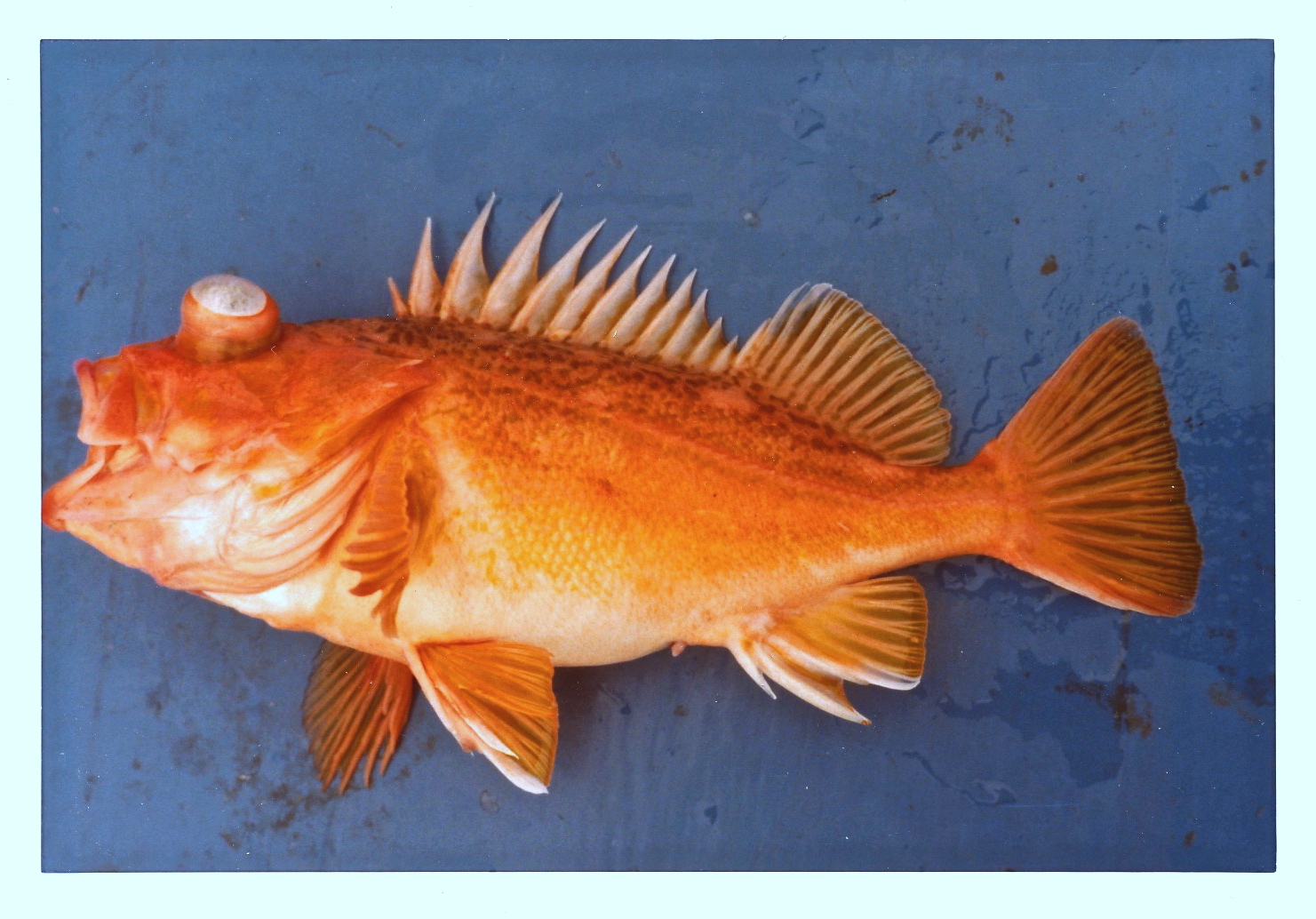

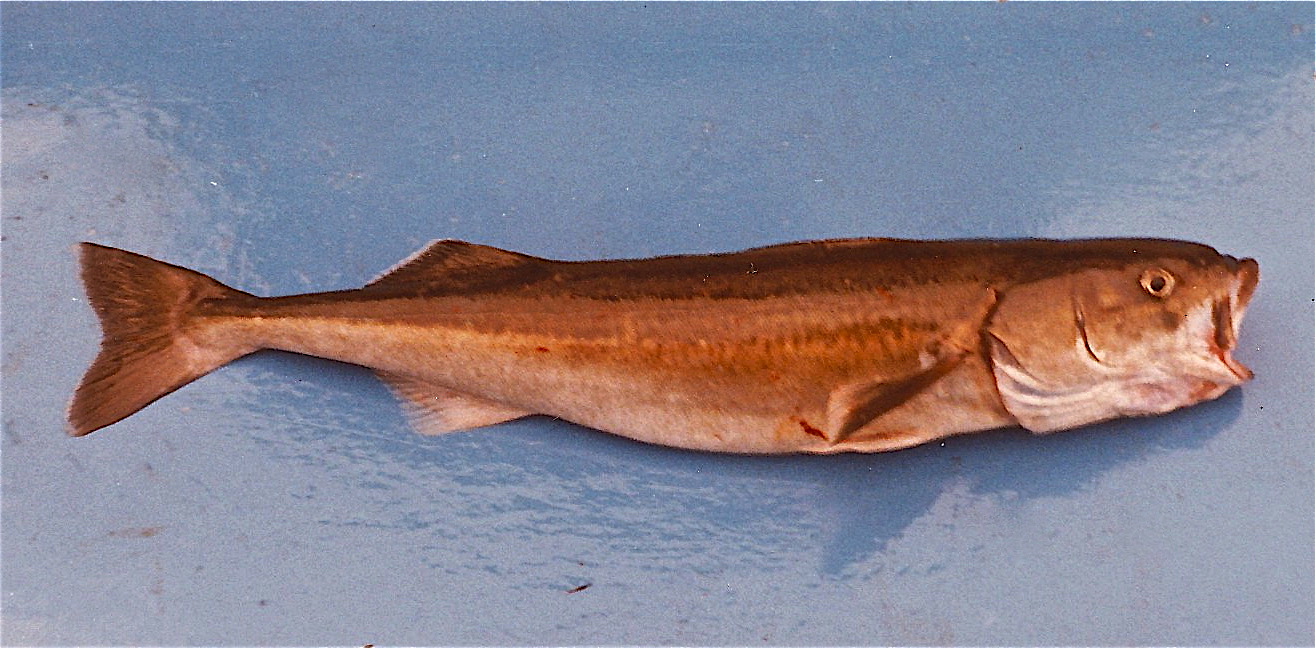

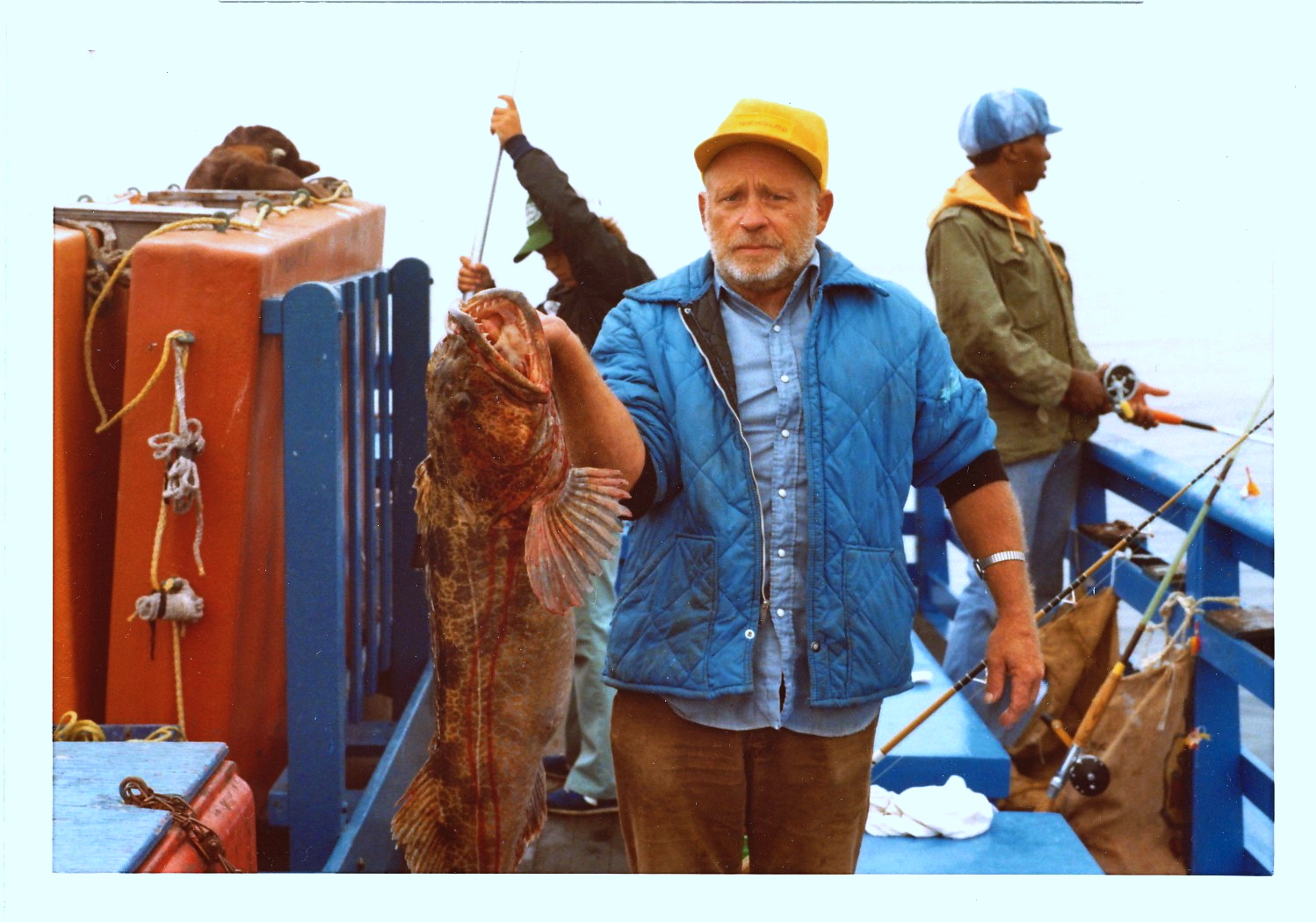
Decent-sized lingcod
Eventually I moved north and stopped fishing on the Stagnaro boats. However, I still respect the Stagnaro operation and still visit their sea food market and restaurant whenever I’m in Santa Cruz. They usually have a good selection of fish at the market and I’ve always gotten a good meal at the restaurant.


Fish and crabs!


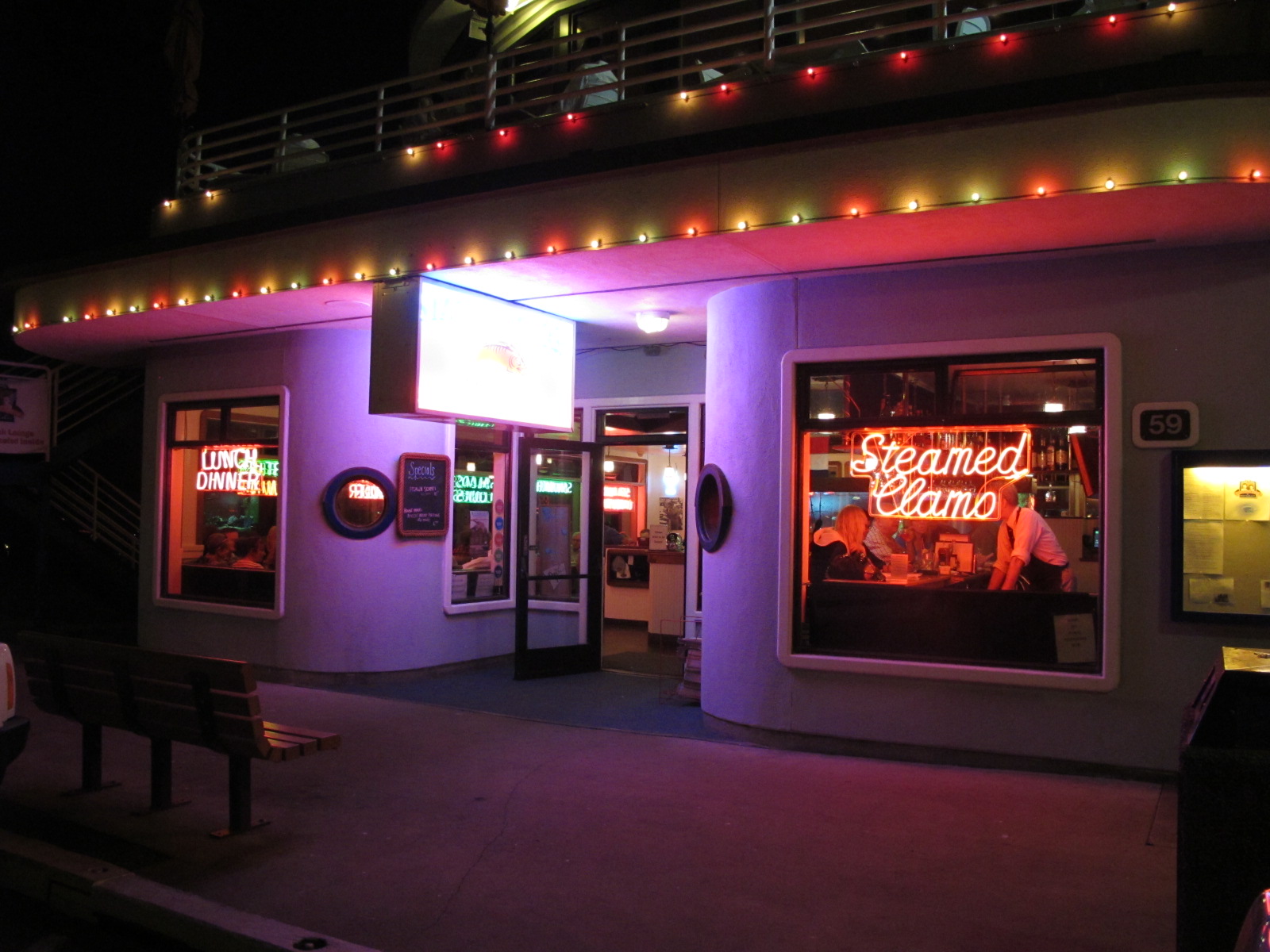
Bring on the food!
History Note. Santa Cruz has existed as a town since 1849 (and it was named after the nearby Santa Cruz Mission). Just four years later, the town’s first wharf was built. This was the infamous “Potato Chute Wharf,” an oddly sloped wharf that allowed potatoes to be slid down a chute from the cliff into rowboats. It was built by Elihu Anthony and Edwin Penfield in 1853, sold to the Davis and Jordan Lime Company in 1857 (who enlarged the wharf), and then acquired by Henry Cowell in 1867. For most of its life it was known as the “Cowell Wharf.” The wharf collapsed during a severe storm on New Year’s Eve in 1907.
__________________________________________
The second wharf, known initially as the Gharkey Wharf, was built by David Gharkey in 1857 and lengthened in 1863.

In 1875 this wharf became the “Railroad Wharf” and was used by the narrow gauge Santa Cruz and Felton Railroad. The wharf had rails that extended to the end where the wharf widened, had a pedestrian walk with railings, and had steps leading down to a platform used for fishermen and fishing boats. In fact, sportfishing boats sailed from this pier in the 1870s. The Railroad Wharf was eventually bought by the South Pacific Coast Railroad, which, in turn, became part of Southern Pacific Railroad in 1887.
By the early 1900s commercial fishing was becoming increasingly important to the area—and to the wharf. A pre-1912 picture of large fish unloaded on the wharf by local commercial fishermen carries with it the name “Fishermen’s Wharf, Santa Cruz.” The Santa Cruz Canning Company operated a large building at the end of the wharf and close by on the wharf was the office of the Western California Fish Company of San Francisco. The wharf would be torn down in 1922.
__________________________________________
In 1863 the California Powder Works built its own wharf opposite Main Street. Initially it was called the “Powder Mill Wharf” but later, after the company left Santa Cruz, it was used by the Pacific Coast Steamship Company and became known as the “Steamship Wharf.” Thrice a week would see an exciting “Steamer Day” when steamers would arrive and be met by local wagons to take arriving visitors into towns. Among the steamers were the large old side-wheelers that ran the San Francisco to San Diego route. Included were the Senator, Ancon, Orizaba. Smaller boats included the City of Chester, Monterey, Eureka, Santa Rosa, San Vicente, Coos Bay, Newport, Salinas, Pomona, Homer, Daisy, Gadsby and Gypsey.
__________________________________________
The fourth wharf was a S-shaped connecting wharf built in 1877 between the “Railroad Wharf” and the “Steamship Wharf.” The “Cross Wharf” was to be used for passenger ships but lived a short life and was demolished in 1882 along with the Steamship Wharf. Steamship service now moved to the end of the “Railroad Wharf.”
The “Railroad Wharf” was not only used by both the railroads and steamships but also became the home to most of the Santa Cruz commercial fishing boats who regularly unloaded huge numbers of fish. There were, however, the occasional storms and tidal waves that can threaten oceanfront wharves/piers.

Fisherman’s Wharf — 1912 (Note the giant black sea bass and large white seabass)

Salmon — 1905 (Picture courtesy of NOAA)
The 1906 earthquake that devastated San Francisco also generated a tidal wave that hit Santa Cruz.
“The wharfinger at Santa Cruz reports that he heard a rumble before the shock, coming from the southeast, and saw the seismic wave traveling shoreward, causing a great rattling and crashing when it struck the town. Two distinct sets of vibration were felt, the latter being the harder. There was very little surf, the water looking like that in a tub when jarred. The wharf, extending southeast, seemed to pitch lengthwise.”
—The California Earthquake of April 18, 1906, Report of the State Earthquake Investigation Commission
__________________________________________
The final wharf was today’s “Municipal Wharf” which was built in 1914. It was started after Santa Cruz failed in its effort to get Southern Pacific to repair and enlarge the “Railroad Wharf.” The city then floated a $172,000 bond issue to build a wharf capable of handling modern deep-water vessels. The opening of the Panama Canal in the summer of 1914 (which increased ship traffic from the East to West Coast), together with rumors that the Federal government might fund a breakwater in northern Monterey County, convinced many that Santa Cruz could become a major West Coast seaport. Soon, 2,260 Douglas fir piles, each 31-75 feet long, gave a base for the 2,745-foot-long wharf.
Formal dedication took place on Saturday, December 5, 1914, before a crowd of 3,000 people. The day was declared an official Santa Cruz holiday and a fish bake barbecue together with a “basket picnic” took place on the beach. At noon, with a band playing, the 267-foot-long steamer Roanoke docked at the wharf along with its cargo and passengers.

Although shippers were now able to transfer directly from ships to trains, that would soon end when railroad service to the wharf ended in 1922. Fifteen years later, in 1937, the last cargo ship departed. Santa Cruz’s bid to become an important seaport was at an end.

Santa Cruz Wharf — 1940s
A fleet of commercial fishing boasts did continue to use the wharf until 1963 but by the 1960s, recreation and tourism were the main roles for the wharf (reflected in Wildlife Conservation Board funds being used to extend the wharf in the early ‘60s).
The Santa Cruz Public Fishing Pier has been completed and the facility will be dedicated and opened this Saturday at 3 p.m. The project included rehabilitating the end 230 feet of the pier, making it suitable for fishing. This restoration will provide angling along both sides of the 230 length and 80 feet across at the end of the pier. The Wildlife Conservation Board financed the project with an allocation of $50,000. The new facility should provide good pier angling for jacksmelt, perch, cod, cabezon, croakers, and flatfish; skates, rays and sharks can also be taken from the pier.
—The Sportsman, Tom Constianino, San Mateo Times, January 17, 1963
Today, it remains the longest public drive-on wharf on the West Coast and is still a must-visit attraction for visitors to Santa Cruz.
Santa Cruz—Located at the northern end of the crescent of Monterey Bay… There are always anglers on the pier but the sea-going sportsmen have been on the increase. Many boats will take out charter parties and there are seven scheduled party boats operating here through the summer.
—W. L. Scofield, Fish Bulletin No. 96, California Fishing Ports, State of California Department of Fish and Game, 1954
__________________________________________
In addition to these “wharves,” structures primarily designed for commerce, there was a pier that reflected the new trend occurring up and down the coast in the early 1900s. This was the 400-foot-long “pleasure pier” that was built by Santa Cruz’s foremost promoter, and later mayor, Fred Swanton. He built the pier in 1904, about the same time he constructed a huge Moorish-style casino and a tent city to attract tourists. This pier was officially called “The Electric Pier” because it was decorated with strings of electric lights that were a novelty at the time. Electricity to the lights was drawn from wiring that was run through the tubing of the railing.

“Electric Pier” — 1906
Designed for tourists, and at a cost of only $1,000, the pier had bright red seats spaced along the pier (called bright vermilion-hue at the time), railings, concessions, and a neoclassical lighthouse out at the 20X62-foot T-shaped end of the pier that served as ticket booth for speedboat rides. Springboards, slides, and a trapeze provided simpler pleasure for many. The pier also carried water lines for the Plunge, an indoor saltwater swimming pool located where today’s tourists play miniature golf. Among the pier’s visitors were fishermen. Unfortunately, when the Plunge was closed in 1960 there was not as great a need for the pier; it was torn down in October of 1962.

The Santa Cruz beach and “Electric Pier”— 1943
Additional wharves were built to the north of Santa Cruz. In 1867 (or 1868), Captain John Pope Davenport, and a friend, John King, built a 450-foot-long wharf at the mouth of the Arroyo del Agua Puerca (Muddy Water Creek), just south of El Jarro Point, and about 18 miles north of Santa Cruz. The wharf was able to reach a water depth of fifteen feet at low tide. The nearby land, part of the old El Jarro rancho, became the site of his whaling operations and gave impetus to Davenport Landing, a prosperous village that included two hotels, a post office, shops, a small shipyard, and a number of homes.
Eventually, the Reese Lime Works constructed a second wharf on the opposite side of the arroyo. Davenport’s wharf would outlast the second wharf but eventually both were destroyed by storms or fire and would disappear, as did Davenport Landing (Old Davenport). Tsunami records record that a “wharf was destroyed at Davenport” in 1875; waves hit on October 12 and an earthquake was recorded two days later on the 14th. Davenport’s wharf continued to be used to load goods onto ships for much of the late 1870s and 1880s, but by the 1890s the wharf was in need of repair and much of the business had declined. In 1915 fire destroyed much of what was left of Davenport Landing but by that time most of the homes had already moved.
A “new” Davenport had sprung up about a mile and a half to the south when the Santa Cruz Portland Cement Company began operations in 1906. That town, on the hillside above San Vicente Creek, is the town you see as you drive on Highway 1. Why did the people move? To avoid the plant’s dust that was blowing over the old site. (And, the plant was kept busy supplying cement to rebuild San Francisco after the 1906 earthquake.) One last pier was built in the area in 1933 (or 1934) when a 2,400-foot-long steel pier was built by the cement company. Remains of the steel pier today are used primarily for nesting by cormorants.
The most northern wharf in Santa Cruz County (at one time) was a 700-foot-long wharf located between Waddell Creek and Point Ano Nuevo. It was built in the early 1860s by William W. Waddell, owner of a lumber mill a few miles away in Canãda de los Osos—Canyon of the Bears. To convey the lumber from his mill to his wharf, he also built a five-mile-long horse tramway that followed the course of Waddell Creek. Waddell was later killed by a grizzly bear; his wharf was destroyed by a storm. By the way, although this wharf was originally in Santa Cruz County, a change to the county boundary line in 1868 meant that the site now rested in San Mateo County.
Santa Cruz Wharf Facts
Hours: Open from 5 A.M. to 2 A.M.
Facilities: The pier has lights, fish cleaning stations, parking on the pier ($1 per every 20 minutes but no charge from 5 a.m. till 10 a.m. , limited benches, snack bars and restaurants, restrooms, and one bait and tackle shop (where the pier first widens).
Handicapped Facilities: Handicapped parking is available (although in many spots parking is available right next to where you fish) and handicapped restroom facilities are available at several spots on the pier. A 38″ railing extends around the wharf and the surface is wood decking. A wooden curb also extends the length of the parking area but it has occasional openings for wheelchair access. Posted for handicapped.
How To Get There: There are many ways to get to the wharf, the way I usually go is to take Ocean Street south from Highway 1, when you get to Laurel Street turn right and follow it to Pacific Street, turn left and follow Pacific to the wharf.
Management: City of Santa Cruz.

i went to Santa Cruz for the first time to fish the pier, but is was too windy. also , nobody knows what fish are in season now. I would like to go back in the next two weeks and try again. Can you tell me what fish are in season from the pier and what beaches i can fish from?
In the photo titled “Santa Cruz Wharf — 1940s” there is a very large white building at the very end of the wharf. As a 10 year old, somewhere about 1955 I used spend a lot of time at the end of the wharf and I remember what I think was a fish processing plant in that large white building but I cannot find any mention of it. Only the one on the Railroad Wharf. I used to climb down the ladders provided for the fishing boat crews when no-one was looking and roam about on the cross beams. I remember the small cranes bringing up large nets full of the fishermen’s catch. I would love to know the name of that processing plant at the far end of the wharf. Thanks! Tom Ballenger
I remember the small cranes bringing up large nets full of the fishermen’s catch 🙂